History notes and photo gallery
Please note that this text is an extract from a reference work written in 1990. As a result, some of the content may not reflect recent research, changes and events.
f) MONTPELIER CRESCENT: In the 1830s and ’40s the site of Montpelier Crescent was a cricket ground known as Lillywhite’s, Lee’s Trap or the Temple Fields Ground; on 29-30 August 1842 Sussex played All-England there. The crescent was erected in 1843-7 by A.H.Wilds, the grandest of his many works, and these original houses, nos.7-31, are decorated with giant fluted pilasters and either Corinthian or ammonite capitals. The wings at nos.1-6 and 32-38 were added in the 1850s, but all the houses are listed and form a magnificent sweeping crescent. {15,44,46}
g) MONTPELIER PLACE: Nos.20-24 are large, bow-fronted, listed houses of about 1855 with balconies. Listed also are no.14, bow-fronted and dating from about 1830, and the Montpelier Inn, a three-storey building of about 1849 with three bows. {44}
The principal building of Montpelier Place is the former St Stephen’s Church, now a grade II*-listed building. Dedicated on 25 July 1851, the interior was reconstructed from the Royal Chapel in Palace Place which itself had been, until 1822, the ballroom of the Castle Inn, constructed originally in 1766 by John Crunden. Following the town’s purchase of the Royal Pavilion estate in 1850, the chapel was claimed by the Church Commissioners as a consecrated building and removed to a new classical building by Cheesemans with pilasters, pediment, and an octagonal lantern with orb and cross. The magnificent ballroom interior, which has a shallow vaulted ceiling and urn frieze supported by columns with foliated capitals, formed a wide rectangular nave with a railed-off sanctuary. Opening on 25 July 1851, the first incumbent was Revd George Wagner whose aunt Mary Wagner provided the land. In 1889 the church was remodelled by Arthur Blomfield, and it was restored in 1908. However, St Stephen’s closed in 1939 and was then used by the Diocesan Association for the Deaf and Dumb, but since 1974 has been the First Base Day Centre for the homeless. In March 1988 the interior was badly damaged by fire, but the centre reopened a year later with the interior splendidly restored. {44,45,64a,65,123,194}
Standing on the boundary between Brighton and Hove is the Baptist Tabernacle, opened on 1 April 1967 on the site of the Emmanuel Church, a Reformed Episcopal church of 1867-8 which was built in Early English style with a south-eastern tower. In the Tabernacle wall is a foundation stone laid by the Revd C.Brake on 1 May 1834 at the original Baptist Tabernacle, an Ionic-style building that stood off West Street but was demolished in 1965 with the Wagner Hall later erected on the site. {62,123}
h) MONTPELIER ROAD: Montpelier Road once ran all the way from King’s Road to Ditchling Road, but the name is now restricted to the section south of Denmark Villas. It was developed from the 1820s in what was considered the most salubrious area of the town and the houses were consequently of a high-class nature with many now listed. The most distinctive are nos.53-56, designed by A.H.Wilds with fluted ammonite pilasters and shell decorations, and nos.91-96, small villas of about 1830 with Ionic doorways, possibly by A.Wilds and Busby. No.90 is notable on account of its cast-iron and stained-glass porch. Other listed houses north of Western Road include nos.51-52, 58-65, 70-74, 76-80, and the unstuccoed nos.36-42; all have late-Regency, wide bow-fronted fa..cs.ades of around 1840. Nos.48-50, with narrow bows, are also listed. No.60 was the home of Revd F.W.Robertson (see “Montpelier Terrace” below) from 1850 until 1853. {44,46,64a,75}
Park Royal, once a private block of flats but purchased by the council in about 1974, stands on the site of Belvedere, a Jacobean-style house erected in about 1840 for Mary Wagner who lived in the adjacent vicarage with her brother Revd Henry Wagner. Now only the garden walls of Belvedere remain, at Belvedere Terrace and in Montpelier Road where the wall is a listed structure. The house was let as a girls’ school, but on Mary Wagner’s death it passed to her nephew Arthur Wagner who lived there from 1870 until 1902. It was later converted into the Park Royal Court Hotel, but was demolished in 1965. {65,123}
The unlisted First Church of Christ Scientist, to the south of Montpelier Terrace, has an elaborately decorated pediment but was originally a private house, obviously so from the rear. It was built in about 1850 and converted into a church in 1921 when the sect moved from the Athenaeum Hall in North Street. {62,83}
j) MONTPELIER STREET: An attractive listed terrace of small, mostly bow-fronted houses of about 1845 lines the western side. No.40, with a wide bow on the eastern side of the road, is also listed. {44}
k) MONTPELIER TERRACE: Nos.1-7, together with no.89 Montpelier Road, form a listed three-storey terrace dating from about 1830 with balconies and Ionic pilasters, although nos.6-7 were added in about 1850. No.1 has a plaque to Ray Noble, the former bandleader and composer who was born there in 1903. Nos.8-13 are a terrace of listed villas with balconies and verandahs of about 1840; the Revd F.W.Robertson, famed for his preaching at Holy Trinity and for founding the Brighton Working Men’s Institute, lived at no.9 from 1847 until 1850. No.14 won a council award in 1983 for its restoration. On the southern side of the road, the red-brick no.16 dates from about 1830, has a fanlight doorway, and is listed along with the late-Regency no.17, Montpellier Hall, of about 1850. {44}
l) MONTPELIER VILLAS: A road lined with delightful, semi-detached Italianate villas, all listed buildings with ironwork balconies and verandahs. Dating from about 1845, they are said to have been built on the site of a bluebell wood and many bluebells still grow in the gardens. No.20 was the home of television personality Gilbert Harding in the 1950s. {3,44,83}
Any numerical cross-references in the text above refer to resources in the Sources and Bibliography section of the Encyclopaedia of Brighton by Tim Carder.
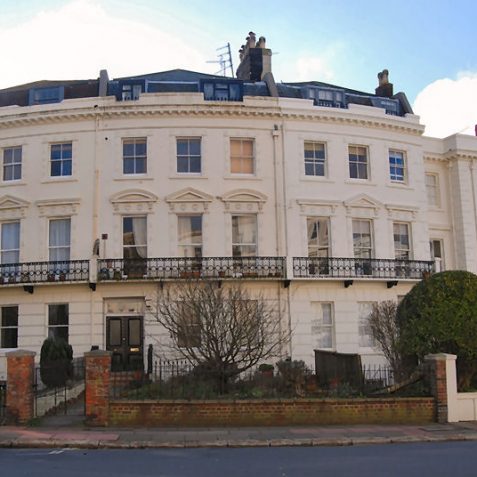



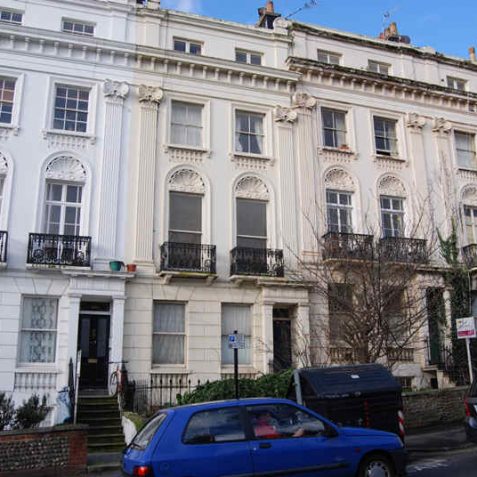
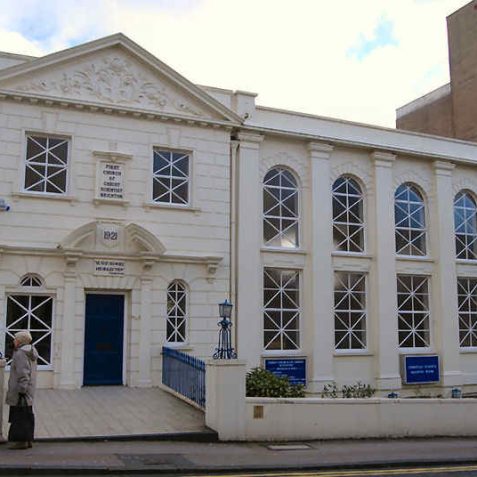
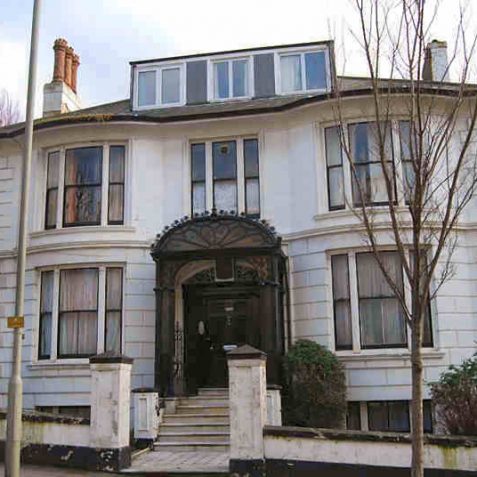
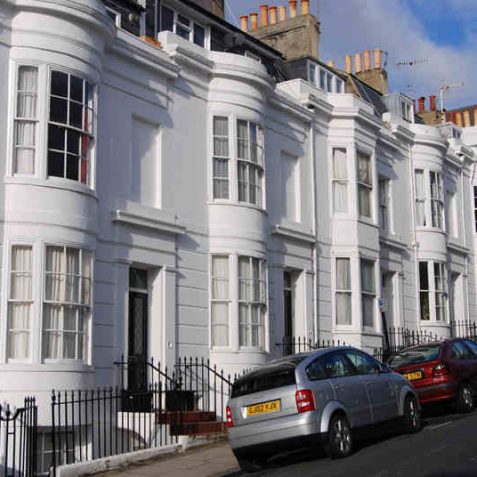


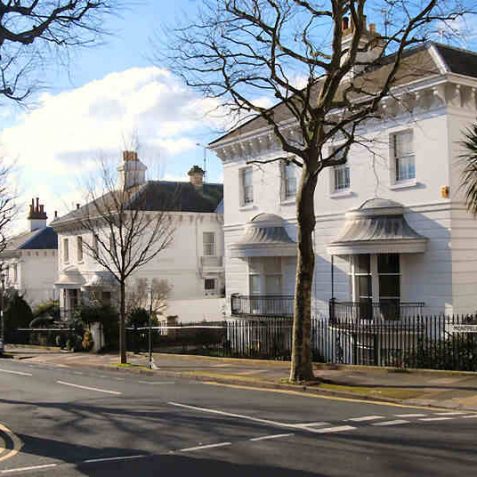
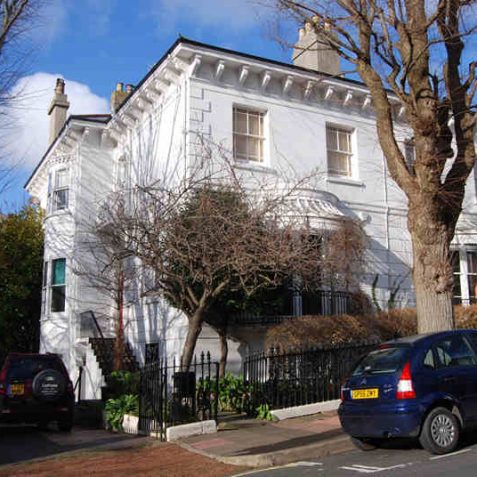




Comments about this page
During the 1940s, 24 or 25 Montpelier Crescent housed Montpelier College with the first head a Dr. Mason who retired about 1947 and was replaced by a Captain Costello who then moved the school to Danny Hurstpierpoint.
Many thanks for your insights on Montpelier Crescent. I currently live in Singapore but I own a flat on the Crescent and was very pleased to see a picture of it and best of all enjoyed reading the brief history. Good luck with the site.
If anyone reads this and has any information on the crescent – I am trying to find Isabel Bell who lived at no 13 around May 1941.
Gilbert Harding could often be seen walking back and forth along Upper North Street on his way from his home as well as returning.
I was a pupil at Montpelier College from 1939 to 1942 and my brother Guy was there before me. Dr Mason was a Christian Scientist. I remember a favourite pastime was climbing the fence into the (forbidden to the boys) small park/gardens enclosed by the Crescent. I don’t remember getting up to any mischief in the gardens – the exciting thing was to be in forbidden territory – and be chased by the gardeners.
I was a pupil at Montpelier College in 1948. I was 9 years old. I was taught in a rectangular brick building at the back of the playground, but occasionally had Algebra lessons with the ‘big boys’ in the main school. The uniform was a royal blue blazer and a blue and yellow tie. I lived in Hangleton (Hove) and travelled by bus to Seven Dials. The buses had outside staircases and an ungloved hand could freeze to the handrail in the winter! Near the bus stop coming home was a baker’s shop. They sold some form of off-ration stodgy chocolate flavoured ‘cakes ‘ – possibly left over cake scraps. It was at this shop that on the day bread came off ration (July 25th 1948), I bought 1/2d or 1d worth of bridge rolls – about 6 I think – and ate them on the bus with no butter or jam. I left when the school moved to Hurstpierpoint, and was never sure whether it became the famous Hurstpierpoint College. From Kevin’s information I now know that it moved to Danny House in Hurstpierpoint which was famous for having LLoyd George to stay frequently during the First World War. It closed in 1950 according to a web item.
Just wanted to pick up on the closing reference in the last comment that – Danny House closed in 1950. It stayed open, at least as a school – Wolstonbury College, for a few years longer. I know that for sure, as I was a boarder there for a few years. Memories of those times are a little hazy, but I remember that the headmaster was Mr. Harris and he had a son called, David. I also recall that my dormitory was called Raleigh. In fact, as I write a few more memories are coming back, like that of a group of us boys going to the cinema in the Head’s car – some in the car and some in the boot! I certainly remember seeing the film “The Robe” while at school at Wolstonnbury College. The Robe was the first Cinemascope film. The school moved to Horsham where it became St. John’s college, if memory serves me right. I also remember the exceptional kindness and generosity of a lady called Mrs De Brune, who lived in the “The Red House” in Hurstpierpoint, where I once stayed as a guest, and was treated like a young prince.
My cousin, the cartoonist Michael Heath, knew Gilbert Harding way back in the 50s. Indeed he used to illustrate one of Harding’s columns in the then fashionable ‘Men Only’ magazine.
After some reflection, I think that Harding’s column was in fact in the magazine Lilliput, which no longer exists. Apologies!
Just found this site after Googling on Montpelier Villas, having discovered that our ancestors used to live there. My ggg grandfather Captain Frederick Marryat, sea captain and author of many books, including the well known ‘Children of the New Forest’ was living in Montpelier Villas from 1833-1834 with his family. So theirs was built before 1845 (see above). I discovered this in David Hannay’s book, ‘The Life of Frederick Marryat’, written in 1889. His ninth child, Florence, was my gg grandmother and she also became a well known authoress and actress. She was born on June 9, 1833 in Brighton, so presumably at the Villas too. She was christened on August 21st, 1833 at St Nicholas, Brighton. Strangely enough, Florence had the nickname ‘Bluebell’ and my cousin has a portrait painted of her in a bluebell wood, so perhaps the inspiration came from the woods that are mentiioned in the description above. Apparently, while he was living at the Villas in 1834, Frederick wrote three of his books: ‘Jacob Faithful’, ‘Mr. Midshipman Easy’ and ‘Japhet in Search of a Father’. Unfortunately David Hannay’s book doesn’t say which of the villas he actually lived in, but thought people might be interested to know that they had been there. Montpelier rang a bell with me anyway, as we used to hang out in the Starlight Rooms back in the early 60’s (lived in Burgess Hill then), so had this mad thought that perhaps we had unknowingly been dancing in the basement of their house!
The comments of old Montpelians encouraged me to contribute to this page and I am delighted to have this opportunity to talk about the old school which was set in the wonderful surroundings of Montpelier Crescent. My brother, Geoffrey Strong, and myself were pupils at Montpelier College located at 25 Montpelier Crescent, Brighton from 1943 until early 1946. My lasting memories are of the Principal, Dr. William E. Mason. He was a thorough gentleman of undoubted integrity and his physical and intellectual presence set a fine example to his pupils. At the time he was about 57 years of age. A picture of him appears in the Montpelier College Newsletter of December 1945 together with details of his teaching career. He retired in December 1945 and on that occasion a Valedictory address was presented by R Core. I got to know the Principal quite well because he taught me in Class 3. Although he was a Christian Scientist the school was undenominational. The College was founded in 1924 as a boarding and day school for boys. The prospectus applicable for the period 1924-1945 mentions that the Principal received boys between six and sixteen who were prepared for various examinations including matriculation.
There was a well-equipped gymnasium in the district which was used as part of the curriculum. Pupils were encouraged to become proficient in organized games and athletics. During our time at the school we played cricket and football on grounds at Hangleton, Hove. Mr Jephson was our football coach reputed to be a former player of the Brighton and Hove Albion. School colours were royal blue and gold and I still have my football shirt, tie and scarf. Mrs Mason was in effect matron. The football team was known as the Wasps. The last sports day under the headship of Dr Mason was held at Hangleton on 11th July 1945.
War memories include the excitement at the school on learning that Allied troops had landed in France in the early hours of Tuesday 6th June 1944. It was difficult to concentrate on lessons that day. A few days later on 14th June while at lessons we heard an unusual and terrifying noise which we learnt later was a pilotless plane (doodle bug or V1) which had passed over the school. I recollect that a Rev. Morgan who taught class 2 was also an Air Raid Warden at an ARP/Civil Defence post located in the Crescent. I also recall that a Miss Channel taught the Junior class. Some names remembered: K. Anthony, Peter Bagguley, R. Barber, J.H. Boswall, Carlsberg, Calo, R. Core, M. Furse, M. Gunn, Hewittson, Jackson, J.S. Leech, Lewis, Geoffrey Philips, K. Simmons, G. Smith, David Starley, R. Stewart, Treacher, Watson, Wilkinson, Winstone.
Captain R. Costello, late of the Canadian Army, took over the school in September 1945 with 111 boys on the register. He immediately commenced a programme of modernization. It would seem that the school moved to Danny Park sometime in 1948 and there is evidence to suggest that it flourished until its abrupt closure in the early part of 1950. After a brief respite the school re-opened as Wolstonbury under the headship of Major Danby-Hunter, BSc. The papers in my possession regarding the school are to be deposited with either the Curator of the Brighton Museum or the East Sussex Record office.
I have just read about Montpelier Road; we lived in a flat at 60 Montpelier Rd, from 1969 till 1971. The Reverend Robertson lived in that house from 1850 to 1853. I believe that Robertson Rd was named after him. Strangly we moved from 60 Montpelier Rd when we bought a house in Robertson Rd – also no.60.
I am responding to a comment left by David Roby on 3.5.2007. My Grandmother was Isabel Bell, and I am wondering whether they are the same person. She had a daughter in 1937, and heard she had a son in 1941, Brighton. Please leave a comment.
I have left you a email pls contact me 🙂
From 1941 to 1947 I attended Montpelier College that was house at 23 or 25 Montpelier Crescent can anyone remember the school. More about the area can be found if you search for the school on this site
I do not wish to lower the erudite tone of the page, nor to draw away attention from the undisputed quality of the architecture, but my memory is of people living in and around the Terrace when I served milk there in the late seventies or early eighties. One lovely old lady told me with pride of her days as a Windmill Girl, and had photos to display her undoubted charms. I also recall an old lady walking along the pavement, wearingg a bathrobe and slippers. It was a cold day. I helped her back to her nursing home, which was close by, and was thanked by the ‘matron’.
Further information about the gardens of the crescent, is that at the start of the war an underground air raid shelter was built under the garden and we used to get into it when it should have been locked to simply play about. It is probably still under the garden to this day as I can recall they just filled in the steps down with earth after the war.
Just a correction on the Park Royal/ Belvedere section. The Park Royal soldiered on as an underused hotel until around 1970, when it was finally sold off, and its last residential guests ejected, to become a nightclub called the Montpelier Rooms. It did not last long, being closed down in 1972, but the building was far too big and old for its purpose. I remember watching it finally being demolished sometime early in 1973- the flats built immediately after. I knew every nook and corner of that spooky old hotel intimately. As a child its grounds were my playground, and I think I wept when it finally went. It was probably the first time I had known a strong feeling of loss. Unfortunately photographs of the place seem as rare as hens’ teeth.
I concur with Danny Doyle (Hello!) about association between Danny and Wolstonbury College. I was a boarder there in early 50s when the Harris’s ran the school. I was also in the dormitory “Raleigh” situated on top floor south wing. I recall climbing Wolstonbury Hill and going to the cinema in Hassocks? I moved with other boarders to Horsham where it became St Johns College.
I’m surprised no one has mentioned the Coney Hill Jazz Club which occupied the basement of the Park Royal Hotel on Friday nights in the 50s. There must be others who, like me, spent many hours listening to Les Woods’ great jazz.
I was at this school from 1949 to 1952. The boys I knew there were Gardener, Hensler, Law, Day, Smith and a boy in my dormitory who came from Bahrein who’s family looked after BOAC. (British Air Ways) I can’t remember his name but I will update later. There were a lot of Persions there names of Fuladgar, Shahim, Cyrus.
If Micheal Mitchell is reading this, give him my regards:)
Add a comment about this page